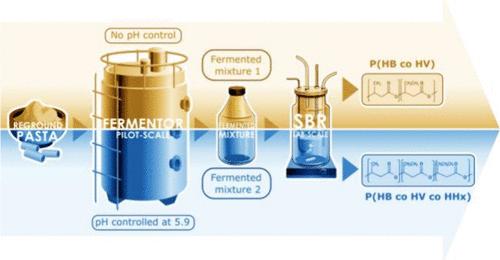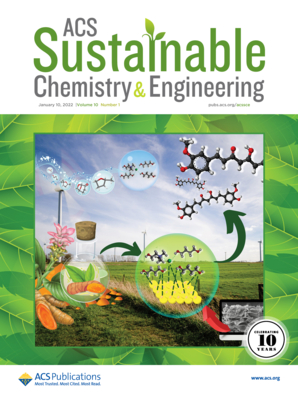Pilot-Scale Acidogenic Fermentation of Reground Pasta Byproduct for Polyhydroxyalkanoate Production with Mixed Microbial Cultures
IF 7.1
1区 化学
Q1 CHEMISTRY, MULTIDISCIPLINARY
引用次数: 0
Abstract
The production of polyhydroxyalkanoates (PHAs) has been herein investigated by using an organic acid mixture originated from a pilot-scale acidogenic fermentation (AF) of reground pasta (RP) byproduct. The pilot-scale AF process was conducted either under no pH control or with the pH maintained at a value of 5.90, with the two obtained fermented mixtures termed RP-fermented 1 and RP-fermented 2, respectively. The fermented mixtures were fed to a lab-scale sequencing batch reactor (SBR), operated at short hydraulic retention time (HRT, 0.5 days) and sludge retention time (SRT, 1 day) and at two values of the applied organic loading rate (OLR) of 2.12 gCODACIDS/Ld and 4.25 gCODACIDS/Ld. During all of the SBR operating conditions, a high selective microbial pressure was established, as confirmed by both the microbiology analysis and the detected values of the storage yield (which reached a maximum value of 0.68 ± 0.04 CODPHA/CODACIDS). A poly(hydroxybutyrate/hydroxyvalerate) copolymer and a poly(hydroxybutyrate/hydroxyvalerate/hydroxyhexanoate) terpolymer were produced with the RP-fermented 1 and RP-fermented 2 streams, respectively. When the OLR of 2.12 gCODACIDS/Ld was applied to the SBR, the stored copolymer and terpolymer presented very similar molecular weights of 339 and 389 kDa, respectively.

求助全文
约1分钟内获得全文
求助全文
来源期刊

ACS Sustainable Chemistry & Engineering
CHEMISTRY, MULTIDISCIPLINARY-ENGINEERING, CHEMICAL
CiteScore
13.80
自引率
4.80%
发文量
1470
审稿时长
1.7 months
期刊介绍:
ACS Sustainable Chemistry & Engineering is a prestigious weekly peer-reviewed scientific journal published by the American Chemical Society. Dedicated to advancing the principles of green chemistry and green engineering, it covers a wide array of research topics including green chemistry, green engineering, biomass, alternative energy, and life cycle assessment.
The journal welcomes submissions in various formats, including Letters, Articles, Features, and Perspectives (Reviews), that address the challenges of sustainability in the chemical enterprise and contribute to the advancement of sustainable practices. Join us in shaping the future of sustainable chemistry and engineering.
 求助内容:
求助内容: 应助结果提醒方式:
应助结果提醒方式:


